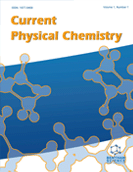Abstract
Aim and Background: Introducing deuterium to a molecule is of interest to a wide variety of research, including investigation of reaction mechanisms or kinetics, analysis of drug metabolism, structural elucidation of molecules, and syntheses of isotopically labeled materials used for NMR spectroscopy and medicinal research.
Objective: The transition-metal-free regioselective deuteration of 2-methylquinolin-8-ol (1a) and 2,5- dimethylquinolin-8-ol (2a) with ambient reaction conditions and low-cost reagents is described in the paper.
Methods: Regioselective H/D isotope exchange has been presented by combining the following techniques 1H NMR, 13C NMR, GC-MS, and X-ray crystallography. The molecular orbitals of the deuterated molecule 1a have been calculated by density functional theory (DFT) to provide an elucidation of the isotope exchange.
Results: The metal-free regioselective green deuteration based on modified Skraup-Doebner-Von Miller synthesis and water-d2 KOD solution or water-d2 D2SO4 solution of hydroxyquinolines was elaborated.
Conclusion: The metal-free regioselective green deuteration of hydroxyquinoline-type compounds with ambient reaction conditions and low-cost reagents provided valuable tools for isotopic labeling. The modified Skraup-Doebner-Von Miller synthesis of deuterated hydroxyquinolines has the potential to allow higher deuteration capacity. The presented isotopic exchange reactions also possess synthetic values as the source of deuterated compounds for the studies of NMR spectroscopy, medicinal research, and drug discovery processes.
Graphical Abstract
[http://dx.doi.org/10.1002/ejoc.201500192]
[http://dx.doi.org/10.1016/0167-7799(87)90088-6]
[http://dx.doi.org/10.1039/CS9972600401]
[http://dx.doi.org/10.2174/1381612003399969] [PMID: 10828300]
[http://dx.doi.org/10.1002/jlcr.1421]
[http://dx.doi.org/10.1002/anie.200700039] [PMID: 17886815]
[http://dx.doi.org/10.1002/jlcr.1818]
[http://dx.doi.org/10.1055/s-0031-1289696]
[http://dx.doi.org/10.1021/ol801763j] [PMID: 18759434]
[http://dx.doi.org/10.1021/jo301903m] [PMID: 23121393]
[http://dx.doi.org/10.1002/anie.200603677] [PMID: 17300115]
[http://dx.doi.org/10.1002/anie.201002351] [PMID: 20632426]
[http://dx.doi.org/10.1002/anie.201305388] [PMID: 24288176]
[http://dx.doi.org/10.1021/cs400420n]
[http://dx.doi.org/10.1039/jr9360000915]
[http://dx.doi.org/10.1038/134734a0]
[http://dx.doi.org/10.1016/j.physb.2004.03.172]
[http://dx.doi.org/10.1016/j.physb.2006.05.126]
[http://dx.doi.org/10.1007/s00249-008-0333-9] [PMID: 18481053]
[http://dx.doi.org/10.1016/j.carbpol.2021.117637] [PMID: 33541662]
[http://dx.doi.org/10.1016/j.saa.2013.08.031] [PMID: 24001976]
[http://dx.doi.org/10.1016/j.molstruc.2010.01.054]
[http://dx.doi.org/10.1016/j.molstruc.2014.04.052]
[http://dx.doi.org/10.1002/mrc.2320] [PMID: 18855329]
[http://dx.doi.org/10.1016/j.molstruc.2012.08.009]
[http://dx.doi.org/10.3390/molecules25092053]
[http://dx.doi.org/10.1002/oms.1210020305]
[http://dx.doi.org/10.1107/S0108768189012929] [PMID: 2344397]
[http://dx.doi.org/10.1107/S0108767307043930] [PMID: 18156677]

















